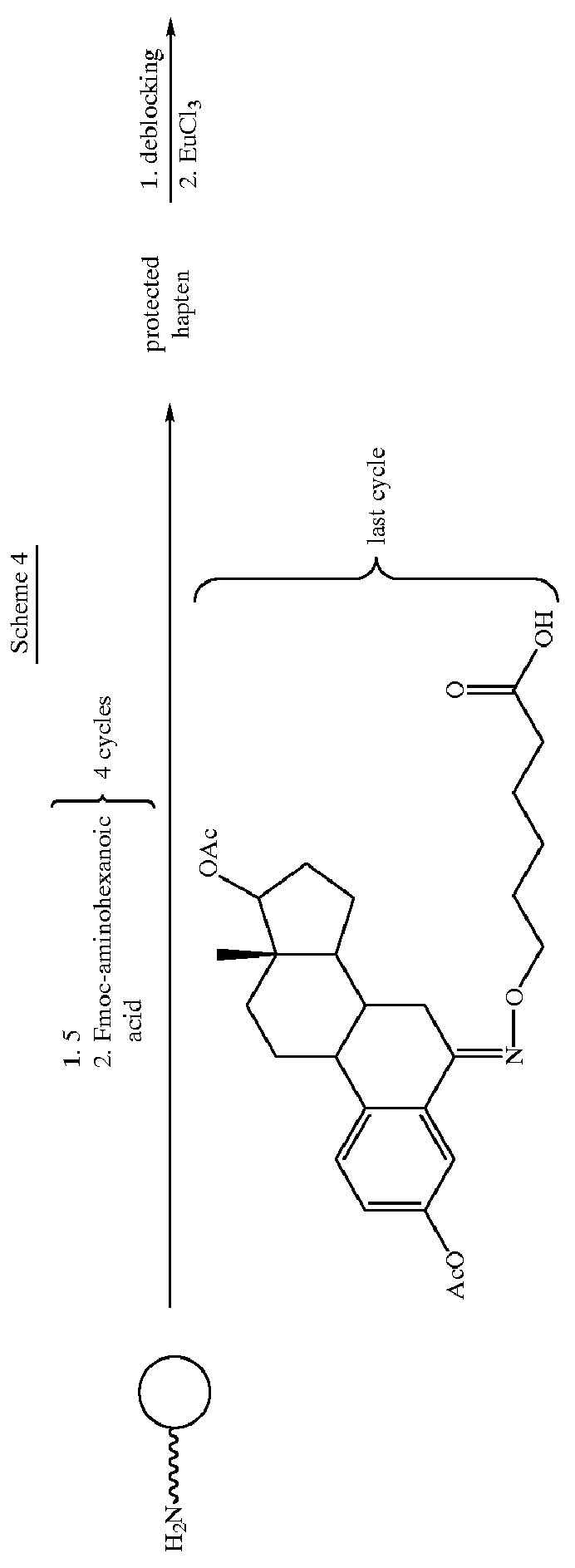Labeling reactants and their use
a technology of reactants and labeling methods, applied in the preparation of carrier-bound/immobilised peptides, carbamic acid derivatives, instruments, etc., can solve the problems of many common drawbacks of labels and labeled biomolecules, the patents and articles present no method for labeling a biospecific, and the loss of spatial information
- Summary
- Abstract
- Description
- Claims
- Application Information
AI Technical Summary
Benefits of technology
Problems solved by technology
Method used
Image
Examples
example 2
The Synthesis of tetra(tert-butyl) 2,2',2,2",2'"-{{4-[4'-(methoxycarbonyl-methoxy)phenylethynyl]pyridine-2,6-diyl}bis(methylenenitrilo)}tetrakis(acetate) (3)
A mixture of tetra(tert-butyl) 2,2',2",2'"-[(4-bromopyridine-2,6-diyl)bis(methylene-nitrilo)]tetrakis(acetate) (1) (2.32 g, 3.4 mmol), bis(triphenylphosphine)palladium(II) chloride (0.050 g, 70 mmol) and CuI (0.027 g, 140 mmol) in dry THF (10 mL) and dry triethylamine (10 mL) was deaerated with argon. Compound 2 (0.79 g, 4.1 mmol) was added and the mixture was stirred for 7 h at 50.degree. C. The cooled solution was filtered, the filtrate evaporated and redissolved in chloroform (150 mL). The solution was washed with water (3.times.150 mL), dried and evaporated. Purification on silica gel (System A) yielded the title compound as an oil (2.01 g, 75%). R.sub.f (A) 0.40. IR (film): 2212 (C.tbd.C), 1750 (C.dbd.O), 1730 (C.dbd.O). .sup.1 H NMR (CDCl.sub.3): .delta. 1.47 (36H, s), 3.50 (8H, s), 3.83 (3H, s), 4.02 (4H, s), 4.67 (2H, s)...
example 3
The Synthesis of 4-{2'",6'"-bis{N,N-bis[(tert-butoxycarbonyl)methyl]-aminomethyl}-4'"-pyridyl}ethynyl}phenoxymethylacetic acid (4)
Compound 3 (1.98 g, 2.5 mmol) was dissolved in 0.25 M KOH (25 mL, 98% EtOH, 2% water) and the mixture was stirred for 10 min at room temperature. The reaction was quenched by addition of 10% aqueous citric acid (100 mL). The resulting suspension was extracted with chloroform (100 mL). The organic layer was washed with citric acid (2.times.100 mL) and water (2.times.100 mL). Evaporation to dryness yielded the title compound as a solid (87%). R.sub.f (B) 0.4. IR (film): 2209 (C.tbd.C). .sup.1 H NMR (DMSO-d.sub.6): .delta. 1.41 (36H, s), 3.48 (8H, s), 3.89 (4H, s), 4.76 (2H, s), 6.99 (2H, d, J 8.8), 7.52 (2H, d, J 8.8), 7.52 (2H, s).
example 4
The Synthesis of 6-{N-{4-{2"-{2'",6'"-bis{N,N-bis[(tert-butoxycarbonyl)methyl]aminomethyl}-4'"-pyridyl}ethynyl}phenoxymethyl-carbonyl}amino}-2-[-N-(fluorenylmethyloxycarbonyl)amino]hexanoic acid (5)
Compound 4 (0.75 g, 0.98 mmol) and N-hydroxysuccinimide (HO-Su) (0.13 g, 1.1 mmol) were dissolved in dry dioxane (30 mL). DCC (0.23 g, 1.1 mmol) predissolved in dry dioxane (5 mL) was added and the mixture was stirred for 4 h at room temperature and filtered on a solution of .alpha.-Fmoc-lysine hydrochloride (0.88 g, 2.2 mmol) in the mixture of dry DMF (15 mL) and pyridine (5 mL). After 4 h, ethanol free chloroform (150 mL) was added and the solution was washed with 10% aq. citric acid (3.times.50 mL) and water (50 mL), dried (4 .ANG. molecular sieves) and concentrated. Purification on silica gel (System B) yielded the title compound as a solid (56%). IR (film): 3315 (OH), 2210 (C.tbd.C), 1681 (C.dbd.O). .sup.1 H NMR (DMSO-d.sub.6): .delta. 1.23 (2H, m), 1.40 (36H, s), 3.10 (2H, m), 3.30 ...
PUM
| Property | Measurement | Unit |
|---|---|---|
| coupling time | aaaaa | aaaaa |
| coupling time | aaaaa | aaaaa |
| excitation energy | aaaaa | aaaaa |
Abstract
Description
Claims
Application Information
 Login to View More
Login to View More - R&D
- Intellectual Property
- Life Sciences
- Materials
- Tech Scout
- Unparalleled Data Quality
- Higher Quality Content
- 60% Fewer Hallucinations
Browse by: Latest US Patents, China's latest patents, Technical Efficacy Thesaurus, Application Domain, Technology Topic, Popular Technical Reports.
© 2025 PatSnap. All rights reserved.Legal|Privacy policy|Modern Slavery Act Transparency Statement|Sitemap|About US| Contact US: help@patsnap.com



